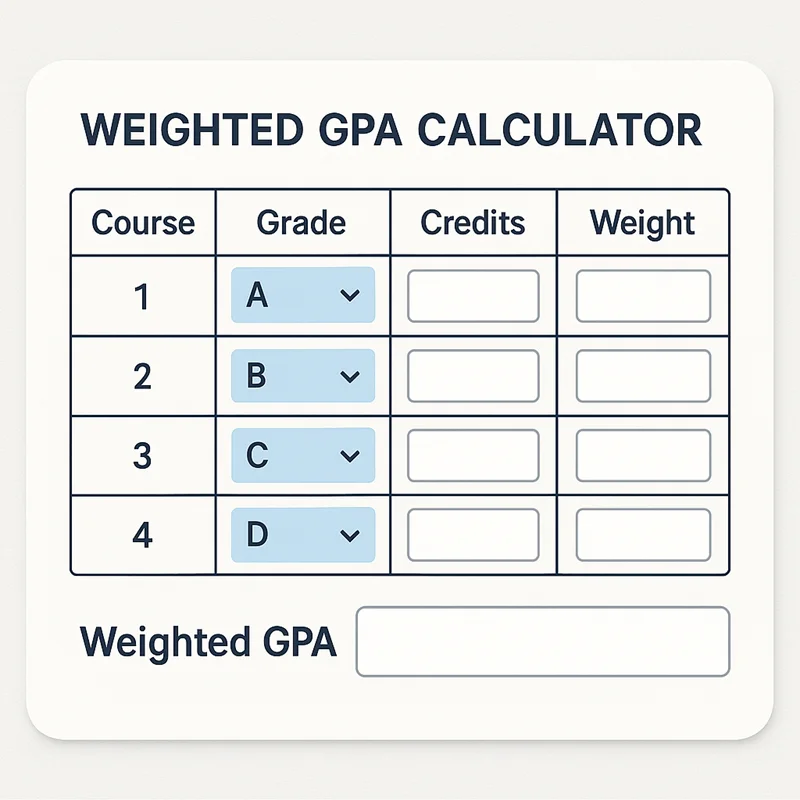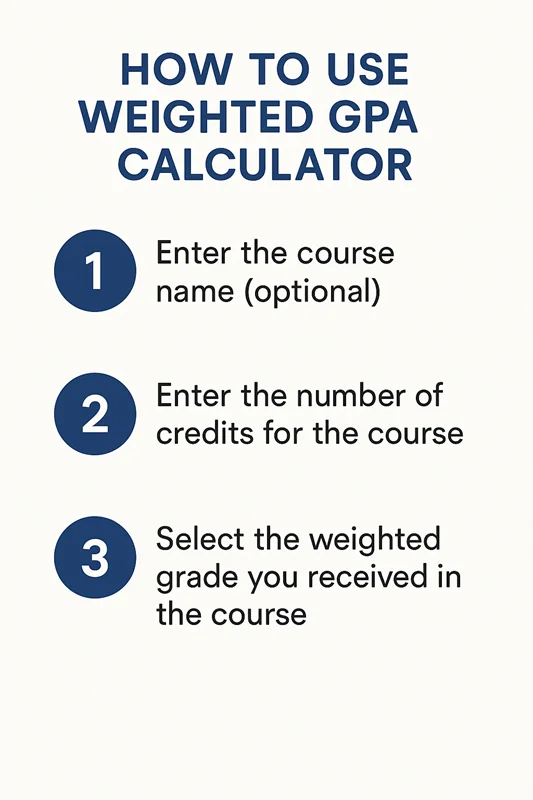A weighted GPA calculator helps high school students accurately calculate their grade point average by accounting for the difficulty level of their courses. This essential tool considers honors, AP, and IB classes that carry additional weight, giving you a true picture of your academic performance and helping you understand how advanced courses can boost your GPA on the 5.0 scale.
Follow these simple steps to calculate your weighted GPA:
A weighted GPA is a grade point average calculation that gives extra points to grades earned in more challenging courses. Unlike an unweighted GPA that treats all classes equally on a 4.0 scale, weighted GPAs can extend beyond 4.0 when students excel in honors, AP, or IB courses.
The weighted vs unweighted GPA difference is significant for college admissions. While unweighted GPAs max out at 4.0, weighted GPAs can reach 5.0 or higher, reflecting the additional rigor of advanced coursework. This honors GPA scale system rewards students who challenge themselves with difficult classes, even if they don’t earn perfect grades.
When using a GPA calculator for AP classes, students typically see a GPA boost from honors courses because these classes add 0.5 to 1.0 extra points to their grade value, depending on the school’s weighting system.

| Letter Grade | Regular Classes (4.0 Scale) | Honors Classes (4.5 Scale) | AP/IB Classes (5.0 Scale) |
|---|---|---|---|
| A+ | 4.0 | 4.5 | 5.0 |
| A | 4.0 | 4.5 | 5.0 |
| A- | 3.7 | 4.2 | 4.7 |
| B+ | 3.3 | 3.8 | 4.3 |
| B | 3.0 | 3.5 | 4.0 |
| B- | 2.7 | 3.2 | 3.7 |
| C+ | 2.3 | 2.8 | 3.3 |
| C | 2.0 | 2.5 | 3.0 |
| C- | 1.7 | 2.2 | 2.7 |
| D+ | 1.3 | 1.8 | 2.3 |
| D | 1.0 | 1.5 | 2.0 |
| F | 0.0 | 0.0 | 0.0 |
| Aspect | Weighted GPA | Unweighted GPA |
|---|---|---|
| Scale Range | 0.0 to 5.0+ | 0.0 to 4.0 |
| Course Difficulty | Accounts for honors, AP, IB | Treats all courses equally |
| College Admissions | Shows academic rigor | Shows raw academic performance |
| Class Rank | Often used for valedictorian | May be used alongside weighted |
| Transcript Display | Usually appears with unweighted | Standard on all transcripts |

A weighted GPA of 4.0 or higher is generally considered competitive for most colleges. Top-tier universities often see applicants with weighted GPAs of 4.5 or higher, while many quality colleges accept students with weighted GPAs in the 3.5-4.0 range.
Colleges typically recalculate GPAs using their own weighting systems since high schools vary in their approaches. They focus more on the rigor of courses taken and grades earned in core academic subjects rather than the specific weighted GPA number.
Yes, but you need the original grades and course information. Simply recalculate using the standard 4.0 scale for all courses, ignoring the extra weight given to honors or AP classes.
No, weighting systems vary significantly between schools. Some add 0.5 points for honors and 1.0 for AP classes, while others may add 1.0 for both or use different scales entirely. Always check your school's specific policy.
Take challenging courses that align with your interests and college goals, but don't overload yourself. A slightly lower grade in an AP class often looks better to colleges than an A in a regular class, but maintaining your mental health and having time for extracurriculars is equally important.
Track your GPA regularly using a weighted GPA calculator to stay informed about your academic progress. Calculate your GPA after each semester to identify trends and make informed decisions about future course selections.
Consider using this high school GPA calculation tool before registration periods to see how different course combinations might affect your overall GPA. Remember that taking advanced courses responsibly is key – it’s better to excel in a moderate number of challenging courses than to struggle with an overwhelming course load.
Most importantly, while GPA is important for college admissions, it’s just one factor. Focus on learning, developing your interests, and building a well-rounded application that showcases your unique strengths and experiences.